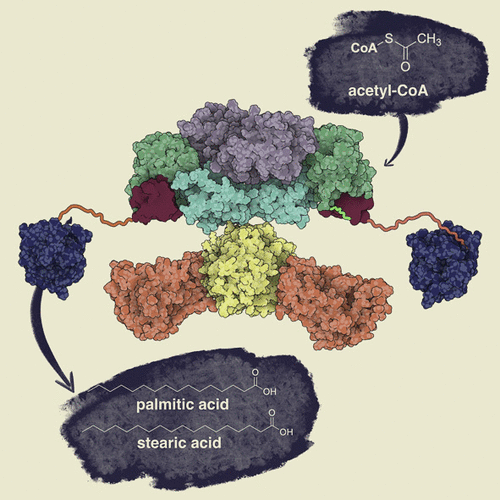当前位置:
X-MOL 学术
›
Chem. Rev.
›
论文详情
Our official English website, www.x-mol.net, welcomes your
feedback! (Note: you will need to create a separate account there.)
Animal Fatty Acid Synthase: A Chemical Nanofactory
Chemical Reviews ( IF 51.4 ) Pub Date : 2021-06-22 , DOI: 10.1021/acs.chemrev.1c00147 Pedro Paiva 1 , Fabiola E Medina 2 , Matilde Viegas 1 , Pedro Ferreira 1 , Rui P P Neves 1 , João P M Sousa 1 , Maria J Ramos 1 , Pedro A Fernandes 1
Chemical Reviews ( IF 51.4 ) Pub Date : 2021-06-22 , DOI: 10.1021/acs.chemrev.1c00147 Pedro Paiva 1 , Fabiola E Medina 2 , Matilde Viegas 1 , Pedro Ferreira 1 , Rui P P Neves 1 , João P M Sousa 1 , Maria J Ramos 1 , Pedro A Fernandes 1
Affiliation

|
Fatty acids are crucial molecules for most living beings, very well spread and conserved across species. These molecules play a role in energy storage, cell membrane architecture, and cell signaling, the latter through their derivative metabolites. De novo synthesis of fatty acids is a complex chemical process that can be achieved either by a metabolic pathway built by a sequence of individual enzymes, such as in most bacteria, or by a single, large multi-enzyme, which incorporates all the chemical capabilities of the metabolic pathway, such as in animals and fungi, and in some bacteria. Here we focus on the multi-enzymes, specifically in the animal fatty acid synthase (FAS). We start by providing a historical overview of this vast field of research. We follow by describing the extraordinary architecture of animal FAS, a homodimeric multi-enzyme with seven different active sites per dimer, including a carrier protein that carries the intermediates from one active site to the next. We then delve into this multi-enzyme’s detailed chemistry and critically discuss the current knowledge on the chemical mechanism of each of the steps necessary to synthesize a single fatty acid molecule with atomic detail. In line with this, we discuss the potential and achieved FAS applications in biotechnology, as biosynthetic machines, and compare them with their homologous polyketide synthases, which are also finding wide applications in the same field. Finally, we discuss some open questions on the architecture of FAS, such as their peculiar substrate-shuttling arm, and describe possible reasons for the emergence of large megasynthases during evolution, questions that have fascinated biochemists from long ago but are still far from answered and understood.
中文翻译:

动物脂肪酸合酶:化学纳米工厂
脂肪酸是大多数生物的关键分子,在物种间传播和保存得很好。这些分子在能量储存、细胞膜结构和细胞信号传导中发挥作用,后者通过它们的衍生代谢物发挥作用。从头脂肪酸的合成是一个复杂的化学过程,既可以通过由一系列单个酶(例如在大多数细菌中)构建的代谢途径来实现,也可以通过单一的、大型的多酶来实现,它结合了脂肪酸的所有化学能力。代谢途径,例如在动物和真菌中,以及在某些细菌中。在这里,我们关注多酶,特别是动物脂肪酸合酶 (FAS)。我们首先对这一广阔的研究领域进行历史概述。我们随后描述了动物 FAS 的非凡结构,这是一种同二聚体多酶,每个二聚体具有七个不同的活性位点,包括一种将中间体从一个活性位点运送到下一个活性位点的载体蛋白。然后,我们深入研究了这种多酶的详细化学过程,并批判性地讨论了当前关于合成具有原子细节的单个脂肪酸分子所必需的每个步骤的化学机制的知识。与此一致,我们讨论了 FAS 在生物技术中作为生物合成机器的潜力和已实现的应用,并将它们与它们的同源聚酮化合物合酶进行了比较,它们也在同一领域得到了广泛的应用。最后,我们讨论了一些关于 FAS 结构的开放性问题,例如它们特有的底物穿梭臂,并描述了在进化过程中出现大型巨合酶的可能原因,这些问题很久以前就吸引了生物化学家,但仍远未得到解答和明白了。
更新日期:2021-08-11
中文翻译:

动物脂肪酸合酶:化学纳米工厂
脂肪酸是大多数生物的关键分子,在物种间传播和保存得很好。这些分子在能量储存、细胞膜结构和细胞信号传导中发挥作用,后者通过它们的衍生代谢物发挥作用。从头脂肪酸的合成是一个复杂的化学过程,既可以通过由一系列单个酶(例如在大多数细菌中)构建的代谢途径来实现,也可以通过单一的、大型的多酶来实现,它结合了脂肪酸的所有化学能力。代谢途径,例如在动物和真菌中,以及在某些细菌中。在这里,我们关注多酶,特别是动物脂肪酸合酶 (FAS)。我们首先对这一广阔的研究领域进行历史概述。我们随后描述了动物 FAS 的非凡结构,这是一种同二聚体多酶,每个二聚体具有七个不同的活性位点,包括一种将中间体从一个活性位点运送到下一个活性位点的载体蛋白。然后,我们深入研究了这种多酶的详细化学过程,并批判性地讨论了当前关于合成具有原子细节的单个脂肪酸分子所必需的每个步骤的化学机制的知识。与此一致,我们讨论了 FAS 在生物技术中作为生物合成机器的潜力和已实现的应用,并将它们与它们的同源聚酮化合物合酶进行了比较,它们也在同一领域得到了广泛的应用。最后,我们讨论了一些关于 FAS 结构的开放性问题,例如它们特有的底物穿梭臂,并描述了在进化过程中出现大型巨合酶的可能原因,这些问题很久以前就吸引了生物化学家,但仍远未得到解答和明白了。











































 京公网安备 11010802027423号
京公网安备 11010802027423号